What happens when a research centre in Belval opens up a “standard” industrial microscope and bolts on a mass spectrometer? Answer: the most powerful device of its kind, which hopefully will lead to breakthroughs in fields from pharmaceuticals to solar energy. It is “the marrying of the microscope with the mass spectrometer that gives something that’s greater than the sum of its parts,” says David Dowsett of the Luxembourg Institute of Science and Technology. “So together they form the highest lateral resolution Sims [secondary ion mass spectrometry] instrument in the world.”
Just how small can its pictures be? “The resolution of the Sims images is around 10 nanometres, which is [approximately] 10,000 times smaller than a human hair.”
Helium ion microscopes use an ion beam (instead of using light or electrons) to scan a sample (other sources such as neon can be used too). Mass spectrometers identify the chemical composition of substances using an ionisation process. But previously the two techniques were never used in one single machine.
In the List-designed device, software keeps track of what is imaged at each moment. “The ion beam strikes a very, very tiny area on the sample; it removes some material. We collect that material and because we know where the ion beam was, we know where that material came from. So as we scan the ion beam across the surface of the material, we build up a picture of what the distribution of different elements in the sample looks like.”
This integration means the lab can conduct “better, and hopefully faster” studies, according to Dowsett. He is currently working with a researcher at the University of Luxembourg, for example, on copper selenide solar cells. Some small portions of the cells are much more effective than others. But it is unknown if that is due to “the shape of the surface” or “if there’s a small variation in, say, the copper or the selenium or the tin concentration” that boosts performance. “And if they know that, they can design a fabrication process that makes the whole chip work as well as that one tiny section.”
Other List researchers are examining nanoparticles, very small ingredients used in products “from toothpaste to ketchup”, to see if, when they enter the body, “they pass harmlessly through you or go into your cells.”
Applied science
The Sims instrument--which weighs about 620kg and sits on a “two-stage anti-vibration platform” and one tonne marble block--went into operation last summer, but Dowsett and several colleagues began working on the multi-million-euro project in 2012. While seed funding came from the National Research Fund (FNR), much of the work has been underwritten by Carl Zeiss, the German firm that manufactures the microscope.
“One of our missions at List is, because we are an applied research centre, everything that we do should have some form of application, and should bring ideally some benefit to Luxembourg.” To that end, List and Carl Zeiss have signed an agreement to build and sell a similar machine to a research facility in Europe and another in the US. More deals could follow.
Dowsett earned a PhD in physics at the University of Warwick and then joined List seven years ago. I asked him if he thought people in the Grand Duchy did not really know about the centre’s work. “I think that sadly is very true. One of the things that has been the most impressive that I found since I moved here is the quality of the laboratories here are absolutely amazing,” he said. “And there are very few other places who would let you take these kinds of instruments and then maybe chop them in half and put something else in.”
This article was first published in the May 2016 issue of Delano magazine. Be the first to read Delano’s articles on paper before they’re posted online, plus read exclusive features and interviews that only appear in the print edition, by subscribing online.
